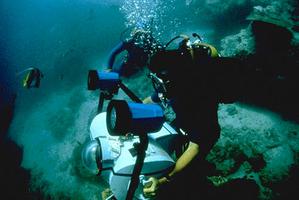
Diving, Underwater
Probably the first large-scale diving efforts, beginning at least 6500 years ago, were directed to acquiring pearls and mother-of-pearl and involved divers trained from childhood for lung capacity and endurance. The first underwater mechanical devices, eg, wooden diving bells, may have been constructed as early as 332 BC and underwent significant modification even before the 19th century.
The first workable diving suit was developed by Augustus Siebe of England about 1839. This waterproof suit had a detachable helmet connected to the surface by a hose through which air was pumped. This kind of tethered suit remained the only practicable diving dress until 1943, when 2 Frenchmen, renowned underwater explorer Jacques-Yves Cousteau and engineer Émile Gagnan, adapted a previously developed breathing apparatus to underwater use. Their improvement was named the "aqualung," or self-contained underwater breathing apparatus (SCUBA).
Commercial Diving
Diving equipment is being continually improved in response to demands from the offshore petroleum exploration industry for diver support to ever greater depths. In some deep water work the dexterity of a diver is not required or the cost of diver compression and decompression is prohibitive. A pressure-resistant diving suit (atmosphere suit), developed in Britain, allows a diver to work to depths of 460 m and return to the surface with none of the usual problems associated with breathing high-pressure gases.
These suits are massive and awkward; lighter and more versatile versions are being developed by Can-Dive Services, a prominent Canadian diving contractor (see ocean industry; submersible).
Recreational Diving
Diving for recreation is popular along Canada's coasts and waterways. Equipment providing the reliability and freedom needed by sport divers was developed a century later than the first standard commercial equipment. Recreational equipment has evolved steadily to the point where divers now use higher-pressure air cylinders, single-hose regulators for easier breathing and drysuits for greater warmth. Submersible diving computers, developed first in Canada by Kybertec International Inc, give continuous digital readouts of depth, time, air consumption and decompression status.
Sport divers are trained by certified instructors who are registered with training agencies. The largest agency in Canada, the National Association of Underwater Instructors, incorporated in 1971, has headquarters at Toronto. American and Canadian Underwater Certification Inc has an office in Burlington, Ont. The Professional Association of Diving Instructors maintains an office in Victoria, BC.
Other agencies providing instruction in Canada are the National Association of Skin Diving Schools, Scuba Schools International and the Confédération mondiale des activités sub-aquatiques. Diving councils and clubs are active throughout Canada, and local diving retailers have information on these groups. The Ontario Underwater Council, the world's largest noncertified association of divers, celebrated 30 years of operation in 1988. This group holds an internationally recognized divers' show in Toronto every spring.
Scientific Diving
Scientists in such fields as archaeology, biology, chemistry, geology, marine ecology, oceanography and physics use diving to make observations and gather data. Canadian researchers are prominent in the Scientific Division of the CMAS, the world federation which was established to promote interest in underwater studies and to advance the techniques and safety of diving.
Canadian scientists and technicians are gaining world recognition for underwater studies carried out in challenging circumstances. Canadian arctic oil development prompted increased research and technological advances in areas such as oil and ice interaction.
Various federal departments and agencies such as Environment Canada, the Environment Protection Service, Fisheries and Oceans, and Energy, Mines and Resources use divers in scientific research. Such divers install and recover recording instruments; help maintain study platforms, canals and locks; collect bottom samples, water samples, fish or invertebrates for analysis; and make surveillance dives in environmentally sensitive areas. One Environment Canada, Parks group has logged thousands of diving hours locating and excavating historic underwater sites.
Noteworthy are San Juan, a Basque whaling galleon sunk in Red Bay, Labrador, in 1565, and Machault, one of 3 French supply ships sunk in Baie des Chaleurs in 1763. The American War of 1812 frigates Hamilton and Scourge, and Breadalbane, an arctic expedition supply ship sunk in the Northwest Passage in 1853, are being investigated by privately funded groups under observation by Environment Canada, Parks (see J.B. MacInnis).
Environment Canada, Parks maintains a support system that includes a 150-t research barge equipped with low-pressure compressors to supply airlifts, with generators to supply underwater lights, a recompression chamber, and offices and workshop facilities. The Royal Ontario Museum used divers to recover artifacts found along the voyageur fur-trading routes and, in 1971, commissioned the search for Hamilton and Scourge. Canada is becoming an internationally recognized leader in underwater archaeology as a result of these enterprises.
Military Diving
The work of military divers ranges from the use of clearance divers on board government vessels to classified defence tasks. The Defence and Civil Institute of Environmental Medicine (DCIEM) is a multidisciplinary laboratory of the Department of National Defence. It provides for the testing and development of personal diving equipment, the training of military personnel, and research and development into the problems associated with human underwater operations.

 Share on Facebook
Share on Facebook Share on X
Share on X Share by Email
Share by Email Share on Google Classroom
Share on Google Classroom
